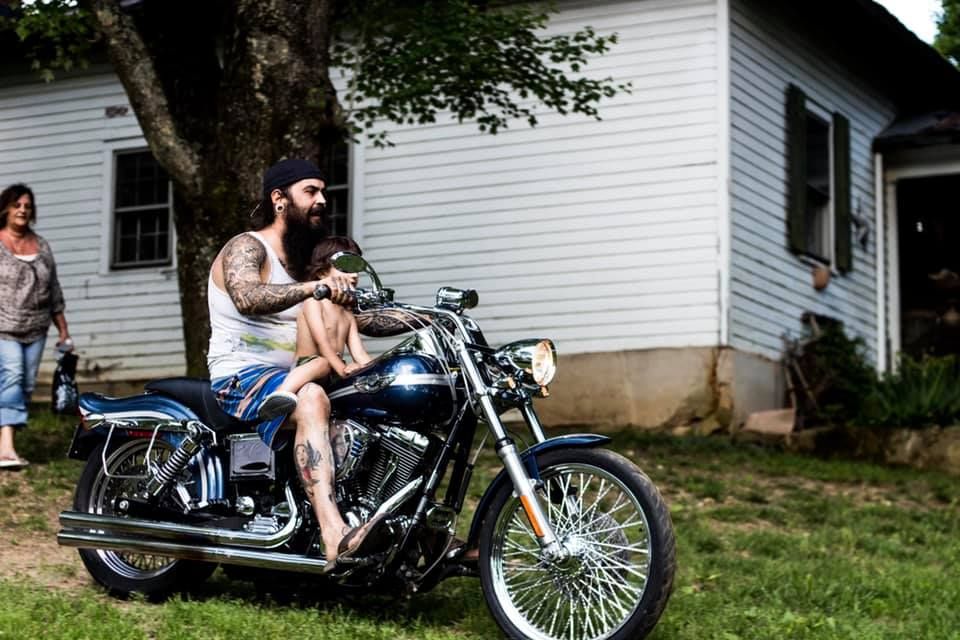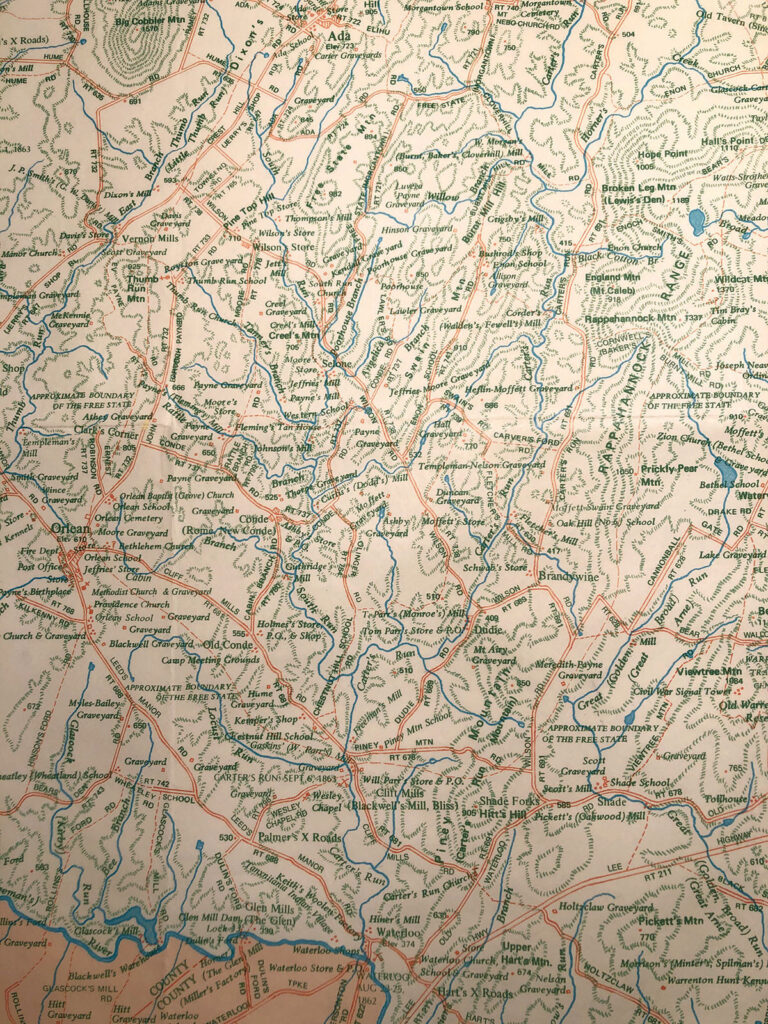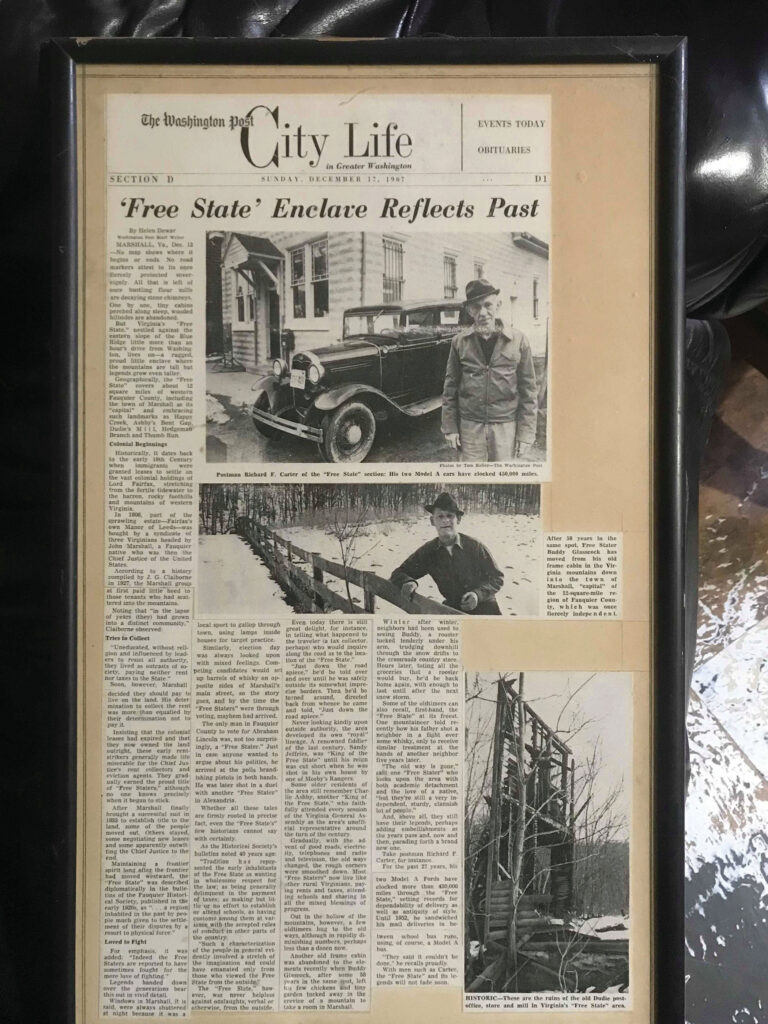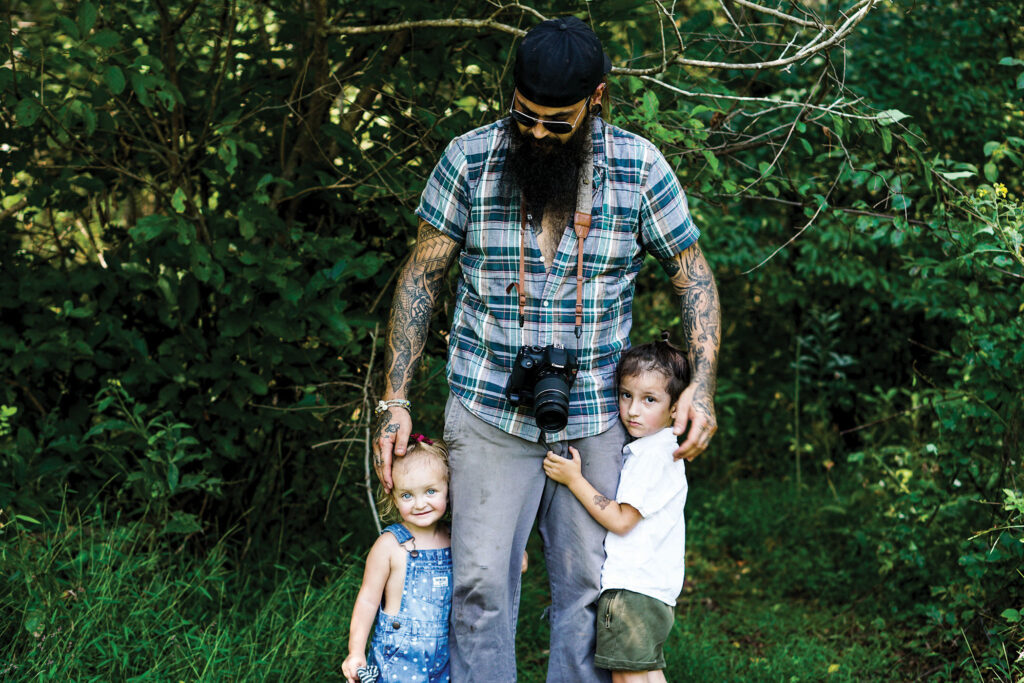The Free State Legend Lives On

Written by Heidi Baumstark
Death and taxes. That familiar claim holds true. But for people living in Fauquier County’s “Free State” area — the tax part — was questionable.
Certainly, Fauquier’s region that conjures up the most mystery is the area known as “Free State.” Its roots stem from the Revolutionary War (1775-1783) era beginning with tenants’ refusal to pay rent and taxes for the land they occupied. After all, that land belonged to Thomas 6th Lord Fairfax of Cameron (1693-1781) and his heirs. Being British, they were the enemy. And colonists beat them during the Revolution, so why should they give money to their enemy?
The question in their mind was: Who owned public lands gained by conquest? The answer carried weighty implications for the status of property rights. After all, they had grown into a distinct community in these remote mountains. And it was this — their defiance of lawful authority and rugged individualism — that earned them the “Free Staters” title.
Where was the Free State?
The region is an approximate 12-mile stretch (about 8,000 acres) in the mountainous land west and southwest of Marshall in Fauquier County, which was established in 1759. The book “250 Years in Fauquier County: A Virginia Story” (2009) places it in the mountains with Thumb Run on the west, Orlean on the south, and the “graded road to Marshall” on the north. The village of Marshall (originally established as Salem in 1796) was considered the capital of the Free State. With no fixed boundaries, no political status, it was referred to as a “state of mind,” according to John K. Gott’s book, “High in Old Virginia’s Piedmont” (1987). This idea became entrenched in the hearts and minds of those known as self-reliant and fiercely independent.
Who were these Free Staters?
Beginning in the early 18th century, immigrants were granted leases to settle on Lord Fairfax’s five-million-acre Northern Neck Proprietary that stretched from the Tidewater to the foothills and mountains of western Virginia, including land between the Potomac and Rappahannock Rivers; basically, it amounted to roughly a quarter of Virginia. Many of those immigrants who came to the Free State were thought to be of German descent. According to a New York Times July 16, 1911 article, many Free Staters were Hessian soldiers who had been hired by the British to fight the colonists during the Revolutionary War. After the Battle of Trenton in New Jersey, hundreds of Hessians were captured by George Washington and the Continental Army the morning of December 26, 1776, a decisive American victory. The 1911 article states these “1,000” captured Hessians “did not go home after the war … they live and flourish to-day in the most aristocratic county of the most aristocratic State in the Union, according to the carefully considered verdict of the inhabitants — Fauquier County, Virginia.”
The New York Times article describes how the Hessians had “looked upon the fields of Fauquier and found them good in their eyes. They had observed, too, that nobody seemed to be exercising any active ownership over large tracts of them. The settlers were few, and the Hessians, finding none to say them nay, squatted upon as much as each man thought would serve his wants.” Gott’s book comments on the Hessians, noting that one Free State leader, Thaddeus “Thad” Gray, was “particularly irked, according to tradition, when Free Staters were sometimes referred to as ‘Hessians.’”
Justin Ashby and his son. Photo by Unearthed Photographical, Ana Gabriele Rodriguez.
When it comes to Free State leaders, “A mythical kingdom needs a king,” Gott wrote. Among the best known “King of the Free State” was Timothy Bray (a senior and a junior) described as squatters living on Wildcat Mountain near Warrenton. A Fauquier County map published by the Warrenton Chamber of Commerce in 1934, shows “Tim Bray’s Cabin” and includes a description that reads: “A portion of Lord Fairfax’s ‘Manor of Leeds’ lay in Fauquier County. While title to this estate was in litigation after the Revolution, the tenants successfully resisted the collection of rents and taxes. Among the best known leaders of this law-defying community was a giant by the name of Tim Bray, the site of whose cabin has been identified [on ‘Wild Cat Mtn.’].”
Later kings were Zibadiah Newhouse and Alexander “Sandy” Jeffries. They had a rowdy reputation of gambling with dice, cock fighting, and making and selling moonshine. During Civil War days, Colonel John Mosby (known as a teetotaler) did not trust Free Staters and excluded the area from “Mosby’s Confederacy,” the region in which Mosby’s Rangers boarded in homes throughout Loudoun and Fauquier, according to Waterford historian and mapmaker Eugene Scheel in a Washington Post April 2, 2000 article. Consulting with Gott, Scheel published one of his popular hand-drawn maps outlining the general Free State boundaries.
In the latter 19th century and into the early 1900s, the king’s mantle passed to Charles (“Charlie”) Burroughs Ashby (1854-1931) who lived at Loch Lomond, the Ashby’s home place built in 1801 on Wilson Road in an area known as “Dudie.” He was the last King of the Free State, known as the unelected spokesman and for his impromptu appearances before the state legislature in Richmond. Though he never forwarded a bill there, he voiced his opinions and those of his neighbors. Except for the Brays, the other “kings” were unofficial.
Top left: Map showing approximate boundaries of the Free State. Courtesy photo by Fauquier Heritage and Preservation Foundation (map drawn by Eugene Scheel). Top right: Ashby family, photo courtesy of Maureen A. Lawrence. Bottom: 1967 Washington Post article, photo from the scrapbook.
“Since I was a kid, I’ve always heard about the Free State,” Ashby descendant, Justin Ashby, of Marshall, said. “I knew it had to do with men who fought in the Revolutionary War and settled on land that Lord Fairfax was overseeing. I heard they ran off the tax collectors. My grandmother said it was good sport to shoot out oil lanterns in house windows up and down Main Street in Marshall — just crazy stuff. I heard stories from family growing up that it was a struggle to continue a life of true freedom. The outside world was changing, and they were holding on to their ways.”
Maureen Ashby Lawrence of Marshall is a ninth generation Ashby going back to the late 1600s. “The Ashbys were landowners; Thomas Ashby came from Virginia’s Tidewater region and settled on Paris Mountain, then Delaplane and Marshall,” she said. Born in 1938, Lawrence grew up in Orlean, but her father (Charles Bryan Ashby) was raised at Loch Lomond. (The stone house at Loch Lomond burned in 1919, but the stone section and chimneys survived, and the house was rebuilt.) “We had such good times going to family reunions at Loch Lomond,” she said, reminiscing.
Lawrence’s grandfather was Nimrod Thomson Ashby. “My grandfather’s uncle was Charlie B. Ashby; ‘Uncle Charlie,’ as we called him, was such a colorful character, a real gentleman, and not a fighter,” Lawrence said. “He was a jack of all trades. He made caskets and even built his own. He loved to hunt and fox hunt. And made moonshine. And I remember hearing about how he rode his horse to Richmond, and he never owned a car.” His 1931 obituary states he had a “knack with horses,” and was “one of the greatest fox hunters that the county has ever known and in all his dealings was upright, honest, and just.” He “stood head and shoulders above the crowd, since he excelled in all he undertook.”
Local resident, Ben Merchant, grew up in The Plains. “I’ve always heard many in the Free State were former Hessian soldiers,” he said. “Growing up in the 1970s, people from Free State would come [to Marshall] and get into fights. They were famous for shooting at tax collectors in the teens, 1920s/30s. They didn’t like authority and were very territorial, very hard working — rough-and-tumble people … and moonshiners. Most Free Staters lived in the Cobbler Mountain area, Ada, Hume, and Orlean.”
What about Lord Fairfax, first owner of the land? And later, John Marshall?
Lord Fairfax first voyaged from England to Virginia in 1735 to 1737 to inspect and protect his land inheritance. He then came back to America, and in 1748, made the acquaintance of George Washington who was then only 16 years old. Fairfax employed him (Washington’s first employment) to survey his lands west of the Blue Ridge Mountains. In 1752, Lord Fairfax ventured to the Shenandoah Valley making his residence at Greenway Court in Frederick County that in 1836, became Clarke County, which borders Fauquier. He spent the remainder of his life there and was the only ennobled British colonial proprietor to live in one of the thirteen colonies. From his Greenway Court estate, he administered his land holdings.
Maureen A. Lawrence holding a scrapbook with Charlie B. Ashby (King of the Free State) in Ashby scrapbook. Photo by Heidi Baumstark.
The land was sparsely settled with virtually no inhabitants beyond the Blue Ridge. The task of Fairfax’s agents — men like Washington and Thomas Marshall (father of John Marshall, for whom the town of Marshall is named) — was to survey the tract and assist in finding people to settle there, arrange title transfers, and collect modest “quitrents” (a tax or land tax).
In making grants of his lands, Lord Fairfax (known as the “proprietor”) leased certain tracts to immigrants representing various nationalities who migrated to what was then the frontier of the colony. According to “Fauquier County, Virginia: Historic Notes” (1914), in the subdivision of his lands in the Northern Neck, Lord Fairfax created a manor which he named “Manor of Leeds” (also known as Leeds Manor) after Leeds Castle, a seat of the Fairfax family in the county of Kent, England. Grants of some of these lands are recorded as early as 1759, the year Fauquier was formed.
Lord Fairfax never married or had children, so upon his death in 1781, the land was inherited by other Fairfax heirs who ultimately sold the 122,850-acre Manor of Leeds on October 18, 1806 to John Marshall (then chief justice of the U.S. Supreme Court from 1801-1835), his brother James Markham Marshall, and his brother-in-law Raleigh Colston, referenced as the “Marshall Syndicate” led by John Marshall. The Free State was only a portion (about 8,000 acres) of this Manor of Leeds tract.
Described in a deed dated August 21, 1767, this 122,850-acre Manor of Leeds tract was in the counties of Loudoun, Fauquier, and Frederick on the northernmost branch of the Rappahannock River, on the upper side of Carter’s Run, on the branches of Goose Creek, on the lower side of the Shenandoah River, and below Happy Creek, including the Blue Ridge Mountain between Happy Creek Gap and Ashby’s Bent Gap. (In addition, there were two other tracts: one containing 26,535 acres and the second one, 13,920 acres, bringing the total acreage to 163,305 in what now belonged to the Marshall Syndicate.)
Here lies the connection. With Thomas Marshall as one of Lord Fairfax’s land agents, his son — John Marshall — became involved, ultimately purchasing Fairfax’s own private Manor of Leeds tract in 1806 from Fairfax’s heirs. While there is no evidence that the young John Marshall met the Proprietor, he easily could have while accompanying his father on surveying expeditions for Lord Fairfax.
When the Manor of Leeds was acquired by the Marshall family in 1806, little attention was at first paid by them to these mountain tenants, who, in the lapse of years, had grown into a distinct community. “Without education or religion and influenced by leaders who encouraged them to resist all authority, they lived as outcasts of society, governed only by their own customs, and paying neither rent to their landlords, nor taxes to the state,” according to the 1914 source.
After so many years undisturbed in their occupation of the land, these residents eventually laid claim to it. And when Marshall attempted to collect rents — or to evict those who refused to pay — they declined to recognize him as their landlord, alleging that the original titles had lapsed. Many lessees argued that the Marshall Syndicate still did not have legal title to the land since they purchased it from heirs of the enemy (Lord Fairfax). So, they continued their refusal to pay. Lawrence added that Free Staters felt they lived there long enough and owned the land, so they didn’t think they had to pay rent or taxes.
Finally, in search of a resolution, in September 1833, Marshall brought a suit in Fauquier County Court in Warrenton (Marshall v. Foley et als.) and won, establishing his title to the land. New leases were then executed by many of the occupants; others left entirely, migrating to the new frontier country further west.
“This officially ended the era of the Free State, but the legend lived on,” Ed Ashby said, whose great, great uncle was Charlie B. Ashby.
Justin Ashby and his children. Photo by Unearthed Photographical, Ana Gabriele Rodriguez.
“Free Staters declared themselves free,” Laura Kelsey, board member of the Fauquier Heritage and Preservation Foundation in the town of Marshall, said. “When Marshall purchased the land in 1806, they tried to evict tenants or collect rents; we’re talking about hundreds of leases. Later, it would be the tax collectors coming after them. Some folks moved away, others stayed and ignored requests to leave or pay rent or taxes. Basically, they ignored whatever they felt like ignoring. By the time Charlie B. Ashby died, lots of people already left; others stayed, and some were squatters. But descendants of Free Staters are still there today.”
A poem titled, “Our Mountain Boys” written in 1879 by Warrenton poet, James DeRuyter Blackwell (1828-1901), sums up the pride and independent spirit of these Free Staters:
“Our mountain boys! Our mountain boys!
Their hearts are bold and true, and pure as the unclouded sky above our mountains blue.
Their step is free as forest deer, like eaglet’s glance their eye, and when the voice of honor bids they did not fear to die.
In vain ye search the lettered page of classic Greece or Rome, for truer and for nobler men than are our boys at home.”
At the time of Charlie B. Ashby’s death in 1931, no official tombstone was laid. At a former Ashby reunion, family members pitched in to help pay for a proper tombstone for him in the family’s burial lot at Loch Lomond. To forever memorialize his role in Fauquier County, Lawrence had these words inscribed on his tombstone: “King of the Free State.”
“Yes, this was the era of the Free State,” Ed Ashby ended. And the legends continue to linger. ML
Published in the January 2021 issue of Middleburg Life.








